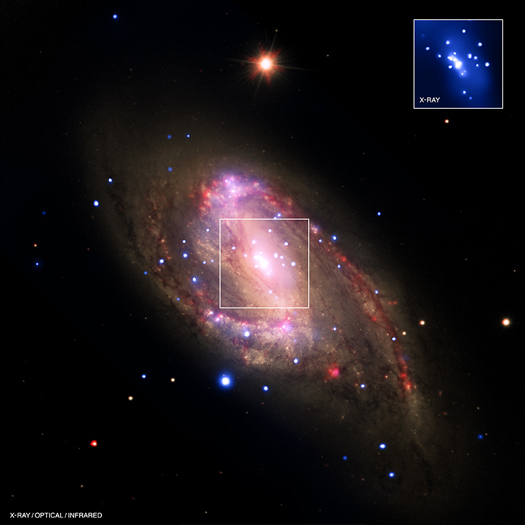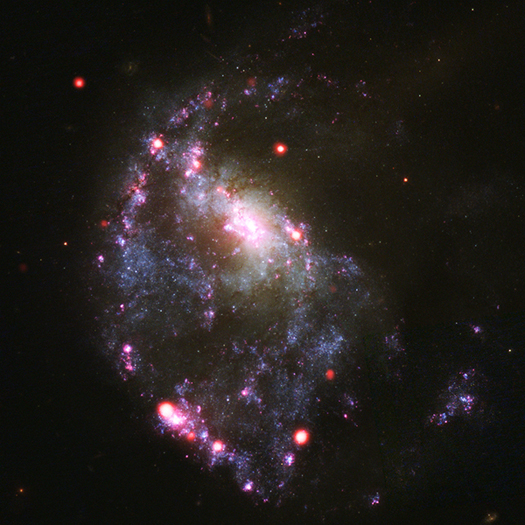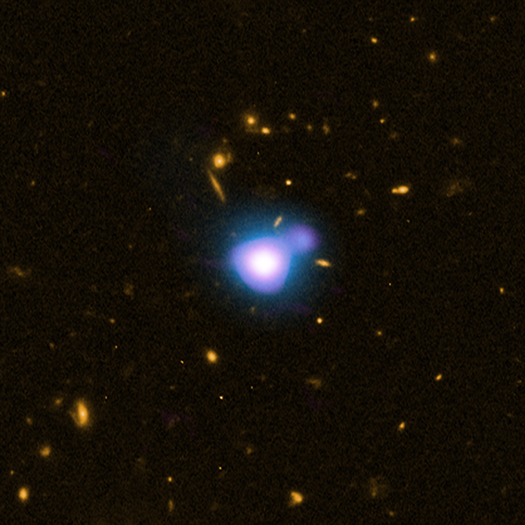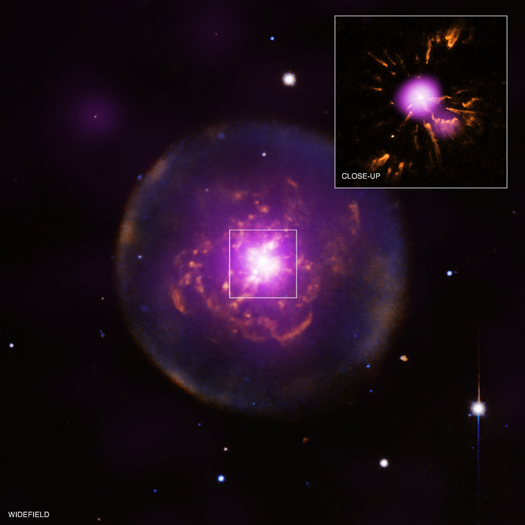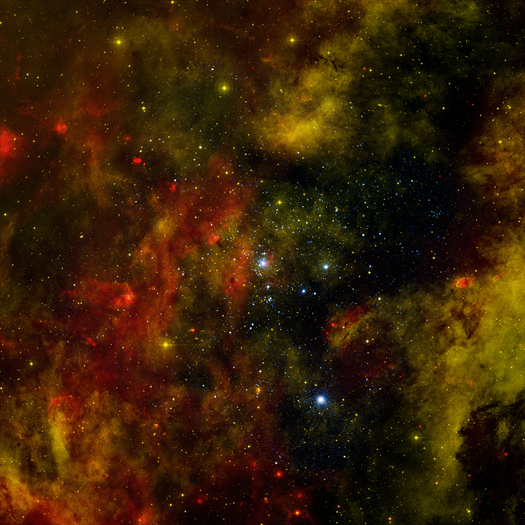Chandra in 2012: A Teenager in Space
In July of 2012, Chandra completed its 13th year of operation, making it a teenager. That is young in human terms, but it is getting up there for an automobile, and could be considered a "senior citizen" for a spacecraft of Chandra's complexity. How many computers do you have that are 13 years old? Chandra's magnificent sister NASA flagship observatory, Hubble, is older, at 22, but astronauts have paid 4 house calls to make major upgrades over the years.
Understanding What's Out There by Looking Down Here
As we've talked about before, science doesn't recognize boundaries. (In fact, we've created the Here, There, Everywhere project to explore this very idea.) Often, scientists need to do experiments here on Earth to better understand what's happening billions of miles away across the Universe.
Revealing Hidden Black Holes
The spiral galaxy NGC 3627 is located about 30 million light years from Earth. This composite image includes X-ray data from NASA's Chandra X-ray Observatory (blue), infrared data from the Spitzer Space Telescope (red), and optical data from the Hubble Space Telescope and the Very Large Telescope (yellow). The inset shows the central region, which contains a bright X-ray source that is likely powered by material falling onto a supermassive black hole.
Searching for the Best Black Hole Recipe
In this holiday season of home cooking and carefully-honed recipes, some astronomers are asking: what is the best mix of ingredients for stars to make the largest number of plump black holes?
They are tackling this problem by studying the number of black holes in galaxies with different compositions. One of these galaxies, the ring galaxy NGC 922, is seen in this composite image containing X-rays from NASA's Chandra X-ray Observatory (red) and optical data from the Hubble Space Telescope (appearing as pink, yellow and blue).
From the Chalkboard to the Diving Board
Stacie Powell is currently a Ph.D. student in astrophysics at Institute of Astronomy at the University of Cambridge, England. She also took a break this past summer to compete in the 10-meter diving platform competition for Great Britain at the 2012 Olympic Games in London. Stacie took some time from her busy schedule to discuss her academic and career path thus far.
I have always had a very questioning mind and liked to learn how the physical processes and objects we see around us can be explained so simply by mathematics. The biggest question in life -- "How did we get here?" -- has always intrigued me. I find astronomy very rewarding as it provides small clues, which are beginning to be pieced together and help us answer this question and, ultimately, to understand the Universe we live in.
How to stumble into a PhD project, and how it can follow you

Teddy Cheung,
Credit: Craig Walker
We are delighted to welcome Teddy Cheung, from the National Academy of Sciences, and resident at the Naval Research Laboratory in Washington DC, to give a guest blog post today. Teddy is first author of a paper describing the discovery of the most distant X-ray jet detected to date. Here, he explains some of the background story behind this discovery.
When I started graduate school in 1999 at Brandeis University, exciting discoveries were being made down the road in Cambridge, Massachusetts, with the then newly launched Chandra X-ray Observatory. The first Chandra image unexpectedly revealed a bright X-ray jet from a distant quasar (https://chandra.harvard.edu/press/99_releases/press_082399.html) and the research groups at SAO and MIT were puzzling over it. But it took me leaving Boston to find my eventual connection.
I spent the summer of 2000 at the Space Telescope Science Institute in Baltimore, Maryland, wanting to learn something entirely new and took on a project in Meg Urry's group studying the galaxies of BL Lac objects (a type of cousin to the quasars) using ground-based near-infrared data. Coincidentally, I shared an office with another graduate student working with Dr. Urry for the summer, Fabrizio Tavecchio from Italy, and they were at that time puzzling over the same Chandra jet detection. Little did I appreciate at the time, that this visit to Baltimore would lead back to my eventual PhD project at Brandeis on the Chandra quasar jets.
Record-Setting X-ray Jet Discovered
This composite image shows the most distant X-ray jet ever observed. X-ray data from NASA's Chandra X-ray Observatory are shown in blue, radio data from the NSF's Very Large Array are shown in purple and optical data from NASA's Hubble Space Telescope are shown in yellow. The jet was produced by a quasar named GB 1428+4217, or GB 1428 for short, and is located 12.4 billion light years from Earth. Labels for the quasar and jet can be seen by mousing over the image. The shape of the jet is very similar in the X-ray and radio data.
X-rays from a Reborn Planetary Nebula
These images of the planetary nebula Abell 30, (a.k.a. A30), show one of the clearest views ever obtained of a special phase of evolution for these objects. The inset image on the right is a close-up view of A30 showing X-ray data from NASA's Chandra X-ray Observatory in purple and Hubble Space Telescope (HST) data showing optical emission from oxygen ions in orange. On the left is a larger view showing optical and X-ray data from the Kitt Peak National Observatory and ESA's XMM-Newton, respectively. In this image the optical data show emission from oxygen (orange) and hydrogen (green and blue), and X-ray emission is colored purple.
A planetary nebula - so called because it looks like a planet when viewed with a small telescope - is formed in the late stage of the evolution of a sun-like star.
Probing a Nearby Stellar Cradle
The Milky Way and other galaxies in the universe harbor many young star clusters and associations that each contain hundreds to thousands of hot, massive, young stars known as O and B stars. The star cluster Cygnus OB2 contains more than 60 O-type stars and about a thousand B-type stars. At a relatively nearby distance to Earth of about 5,000 light years, Cygnus OB2 is the closest massive cluster. Deep observations with NASA's Chandra X-ray Observatory of Cygnus OB2 have been used to detect the X-ray emission from the hot outer atmospheres, or coronas, of young stars in the cluster and to probe how these great star factories form and evolve. About 1,700 X-ray sources were detected, including about 1,450 thought to be stars in the cluster. In this image, X-rays from Chandra (blue) have been combined with infrared data from NASA's Spitzer Space Telescope (red) and optical data from the Isaac Newton Telescope (orange).
Thanks for Everything, Atlantis and Endeavor

As the human spaceflight plans at NASA transition away from the Shuttle program, there have been lots of goodbyes. And hellos. Recently, both the Space Shuttles Atlantis and Endeavor found new permanent homes in their post-flight lives. Atlantis is now at the Kennedy Space Center Visitor Center in Florida, and Endeavor will be found from now on at the California Science Center in Los Angeles.
At each location, NASA held a welcome home/retirement party for the Shuttles. As we've talked about before , the Shuttle program did so much more than just take people into space (which, of course, is a very important job). It also delivered many unique and important telescopes and instruments into orbit – including the Chandra X-ray Observatory.


